外研版中考英语总复习(中册)第三篇 语法考点焦聚 专题07 动词分类
文档属性
| 名称 | 外研版中考英语总复习(中册)第三篇 语法考点焦聚 专题07 动词分类 | 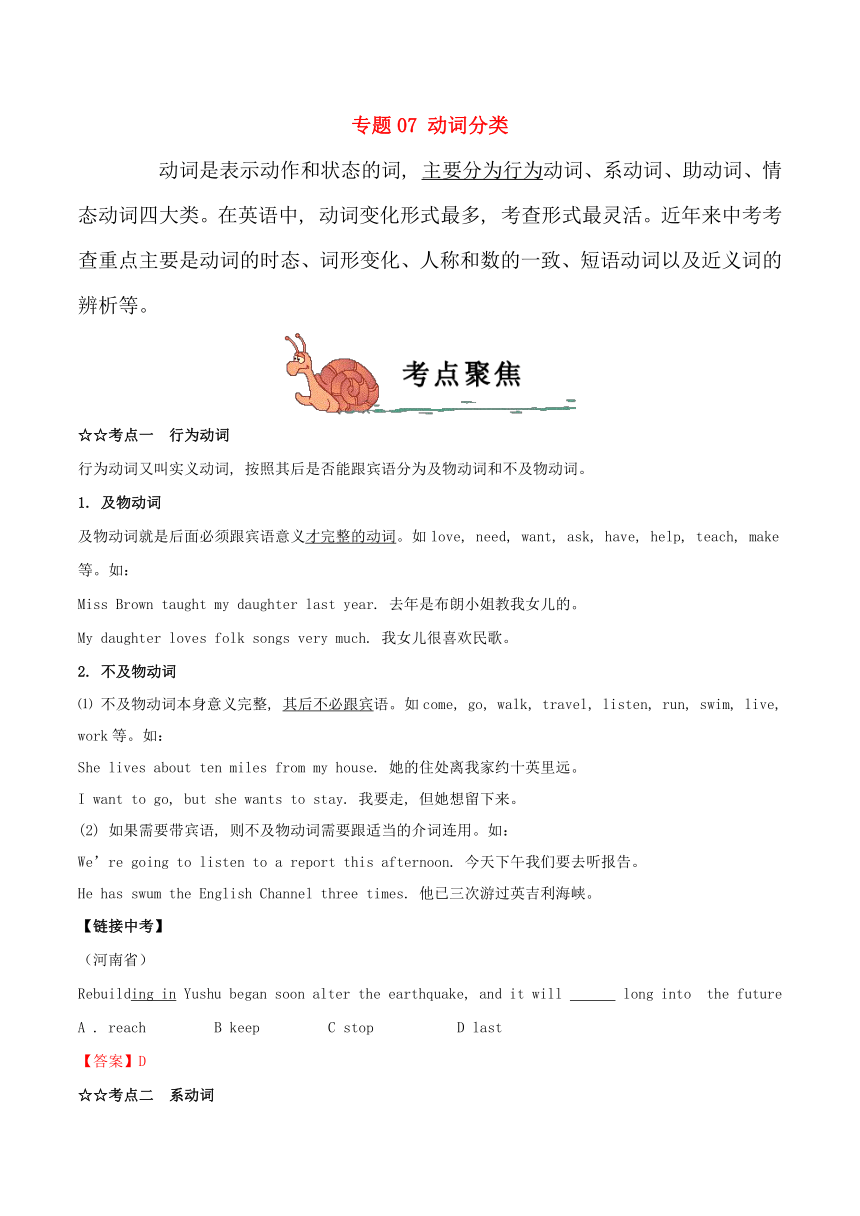 | |
| 格式 | zip | ||
| 文件大小 | 32.8KB | ||
| 资源类型 | 教案 | ||
| 版本资源 | 外研版 | ||
| 科目 | 英语 | ||
| 更新时间 | 2016-08-25 21:36:43 | ||
图片预览

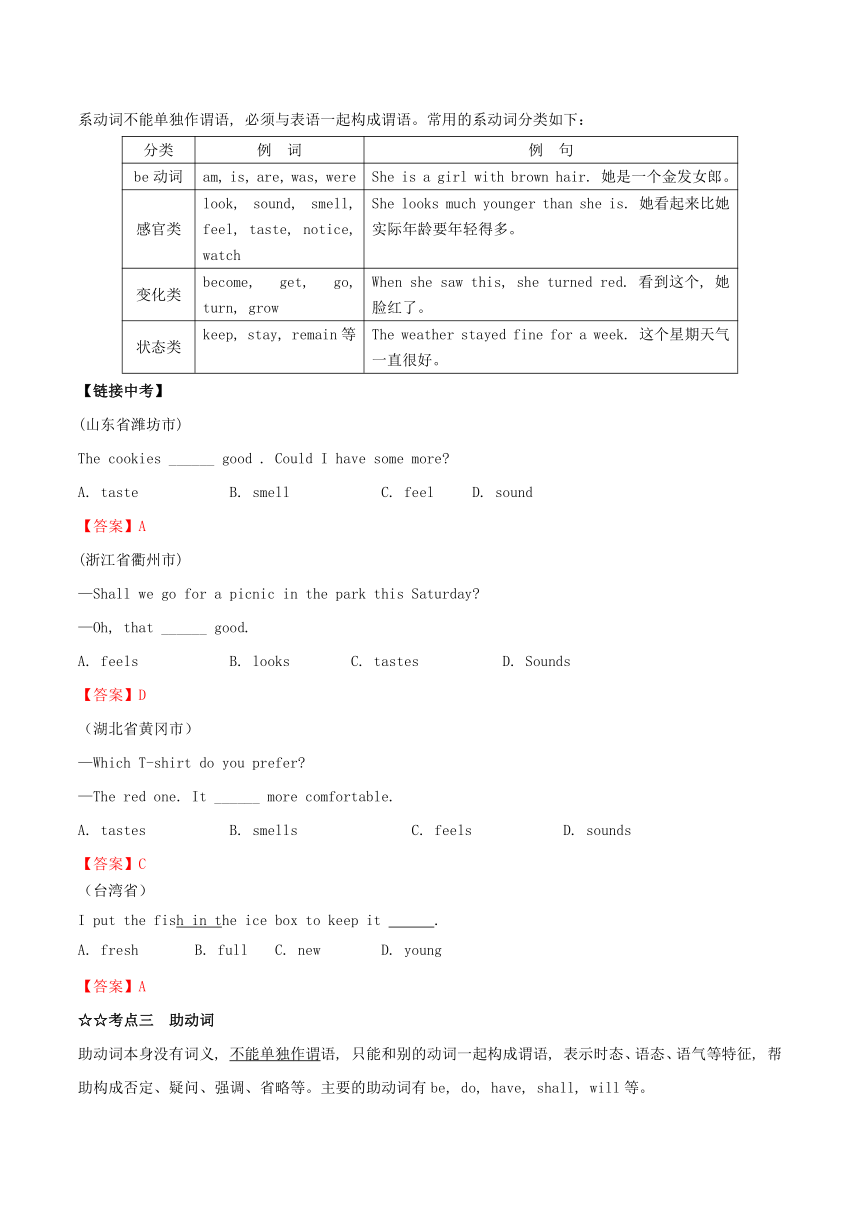
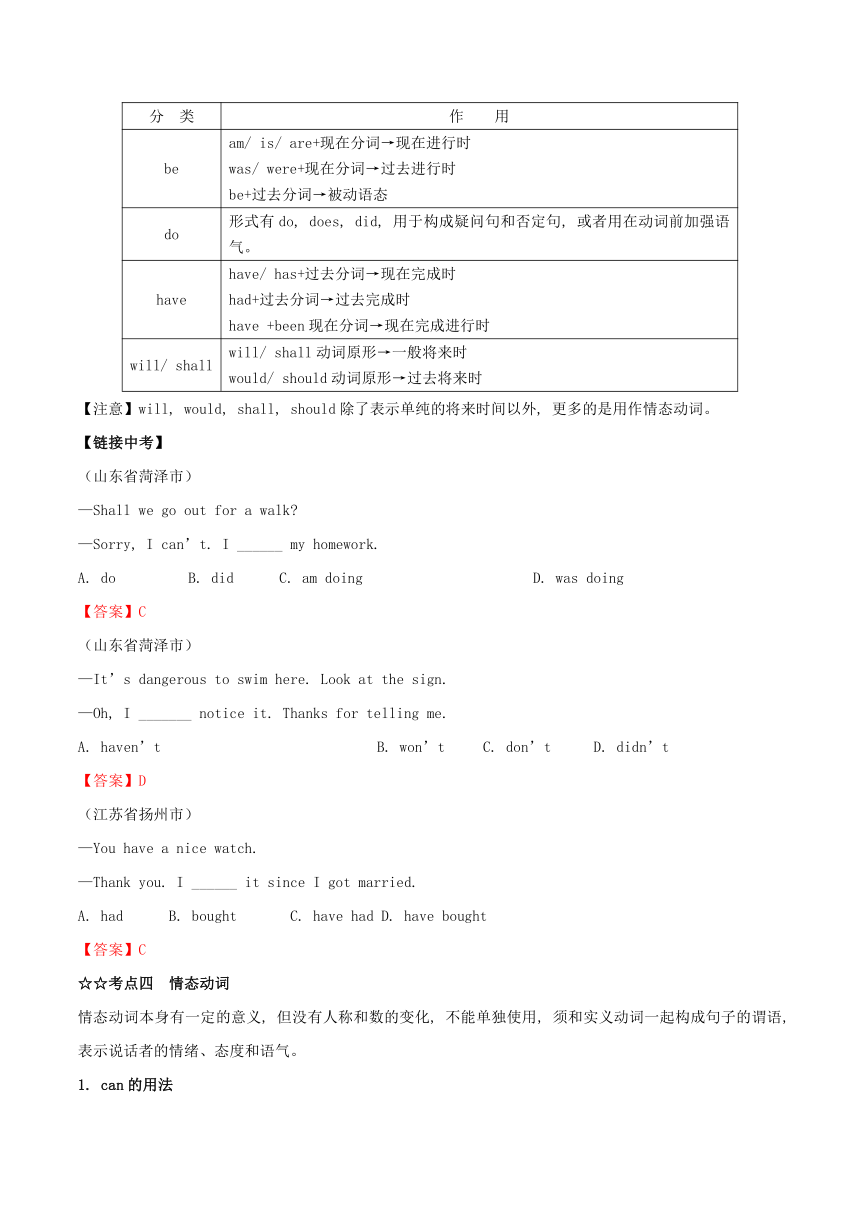
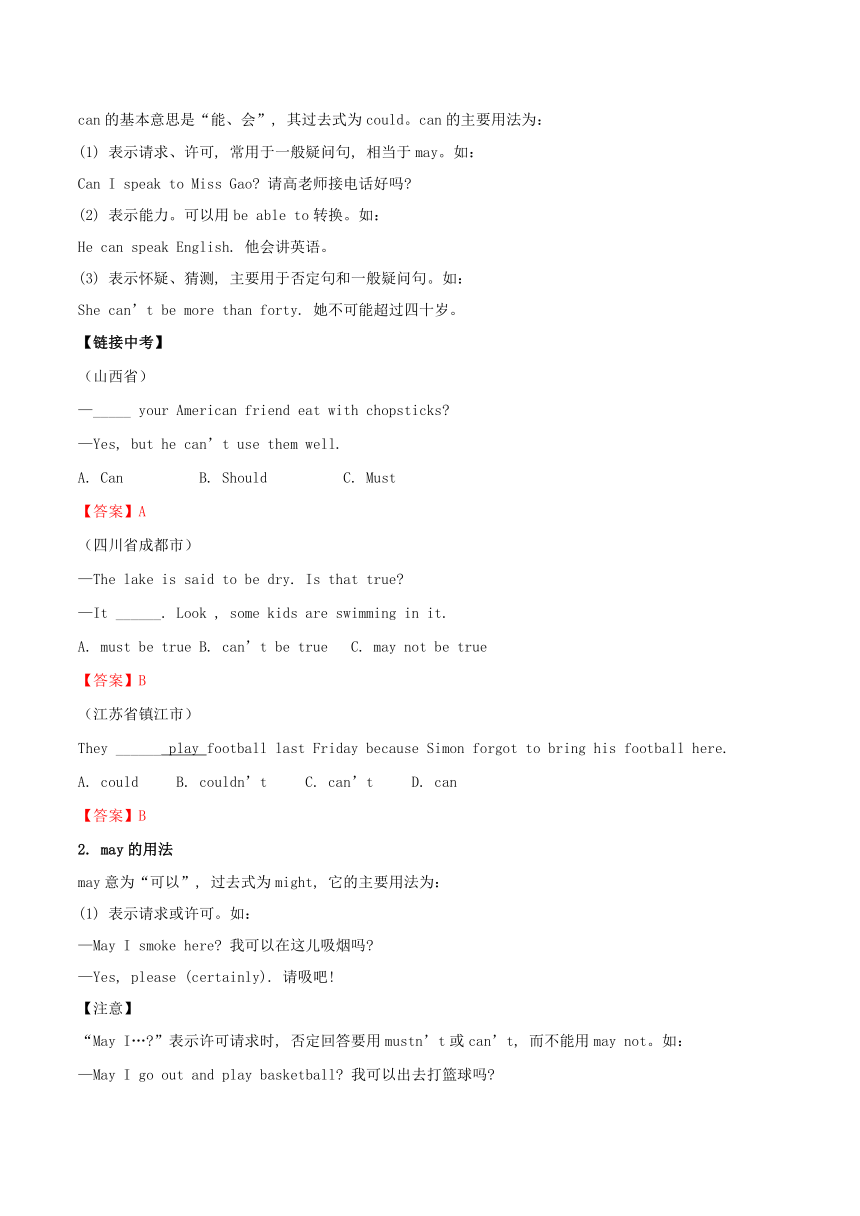
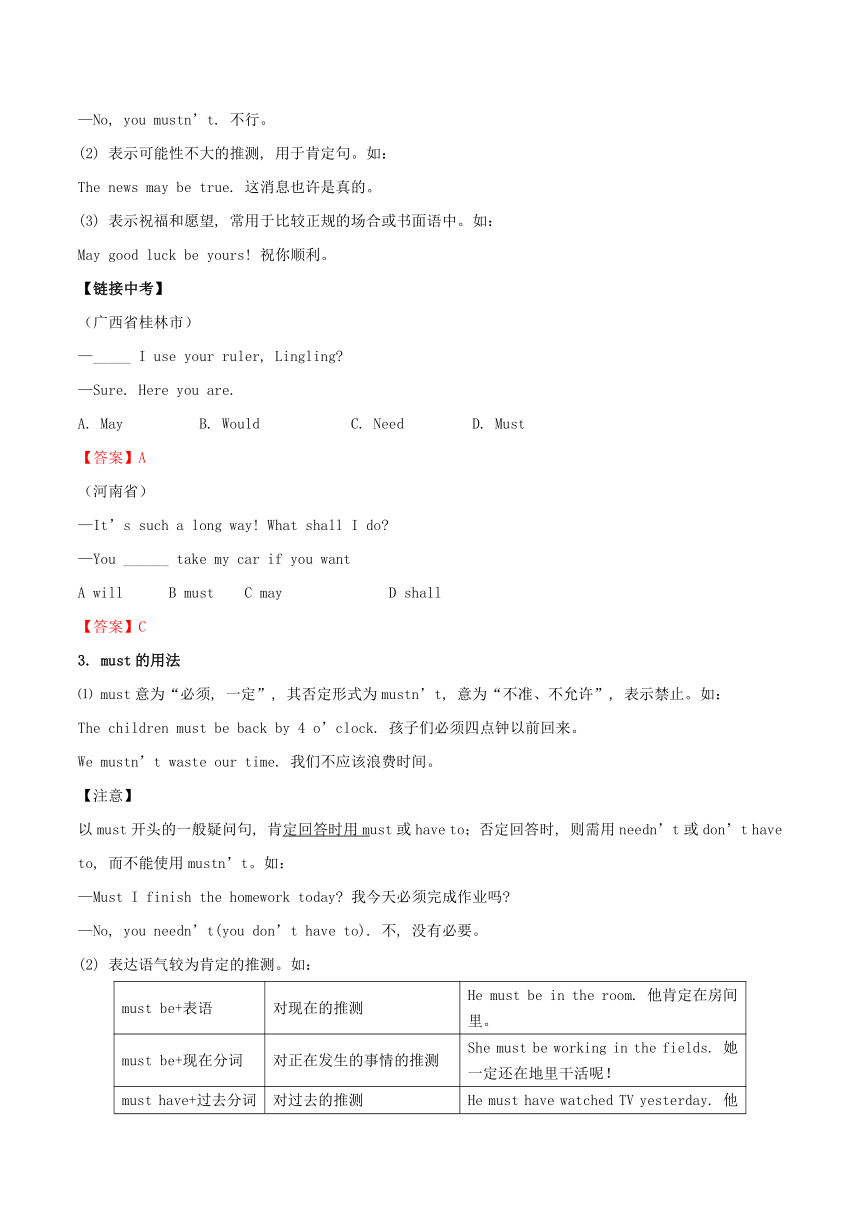
文档简介
专题07
动词分类
动词是表示动作和状态的词,
主要分为行为
( http: / / www.21cnjy.com )动词、系动词、助动词、情态动词四大类。在英语中,
动词变化形式最多,
考查形式最灵活。近年来中考考查重点主要是动词的时态、词形变化、人称和数的一致、短语动词以及近义词的辨析等。
( http: / / www.21cnjy.com )
☆☆考点一
行为动词
行为动词又叫实义动词,
按照其后是否能跟宾语分为及物动词和不及物动词。
1.
及物动词
及物动词就是后面必须跟宾语意义才完整的动词
( http: / / www.21cnjy.com )。如love,
need,
want,
ask,
have,
help,
teach,
make等。如:
Miss
Brown
taught
my
daughter
last
year.
去年是布朗小姐教我女儿的。
My
daughter
loves
folk
songs
very
much.
我女儿很喜欢民歌。
2.
不及物动词
⑴
不及物动词本身意义完整,
其后不必跟宾
( http: / / www.21cnjy.com )语。如come,
go,
walk,
travel,
listen,
run,
swim,
live,
work等。如:
She
lives
about
ten
miles
from
my
house.
她的住处离我家约十英里远。
I
want
to
go,
but
she
wants
to
stay.
我要走,
但她想留下来。
(2)
如果需要带宾语,
则不及物动词需要跟适当的介词连用。如:
We’re
going
to
listen
to
a
report
this
afternoon.
今天下午我们要去听报告。
He
has
swum
the
English
Channel
three
times.
他已三次游过英吉利海峡。
【链接中考】
(河南省)
Rebuilding
in
( http: / / www.21cnjy.com )
Yushu
began
soon
alter
the
earthquake,
and
it
will
long
into
the
future
A
.
reach
B
keep
C
stop
D
last
【答案】D
☆☆考点二
系动词
系动词不能单独作谓语,
必须与表语一起构成谓语。常用的系动词分类如下:
分类
例
词
例
句
be动词
am,
is,
are,
was,
were
She
is
a
girl
with
brown
hair.
她是一个金发女郎。
感官类
look,
sound,
smell,
feel,
taste,
notice,
watch
She
looks
much
younger
than
she
is.
她看起来比她实际年龄要年轻得多。
变化类
become,
get,
go,
turn,
grow
When
she
saw
this,
she
turned
red.
看到这个,
她脸红了。
状态类
keep,
stay,
remain等
The
weather
stayed
fine
for
a
week.
这个星期天气一直很好。
【链接中考】
(山东省潍坊市)
The
cookies
______
good
.
Could
I
have
some
more
A.
taste
B.
smell
C.
feel
D.
sound
【答案】A
(浙江省衢州市)
—Shall
we
go
for
a
picnic
in
the
park
this
Saturday
—Oh,
that
______
good.
A.
feels
B.
looks
C.
tastes
D.
Sounds
【答案】D
(湖北省黄冈市)
—Which
T-shirt
do
you
prefer
—The
red
one.
It
______
more
comfortable.
A.
tastes
B.
smells
C.
feels
D.
sounds
【答案】C
(台湾省)
I
put
the
fish
in
t
( http: / / www.21cnjy.com )he
ice
box
to
keep
it
.
A.
fresh
B.
full
C.
new
D.
young
【答案】A
☆☆考点三
助动词
助动词本身没有词义,
不能单独作谓
( http: / / www.21cnjy.com )语,
只能和别的动词一起构成谓语,
表示时态、语态、语气等特征,
帮助构成否定、疑问、强调、省略等。主要的助动词有be,
do,
have,
shall,
will等。
分
类
作
用
be
am/
is/
are+现在分词→现在进行时was/
were+现在分词→过去进行时be+过去分词→被动语态
do
形式有do,
does,
did,
用于构成疑问句和否定句,
或者用在动词前加强语气。
have
have/
has+过去分词→现在完成时had+过去分词→过去完成时have
+been现在分词→现在完成进行时
will/
shall
will/
shall动词原形→一般将来时would/
should动词原形→过去将来时
【注意】will,
would,
shall,
should除了表示单纯的将来时间以外,
更多的是用作情态动词。
【链接中考】
(山东省菏泽市)
—Shall
we
go
out
for
a
walk
—Sorry,
I
can’t.
I
______
my
homework.
A.
do
B.
did
C.
am
doing
D.
was
doing
【答案】C
(山东省菏泽市)
—It’s
dangerous
to
swim
here.
Look
at
the
sign.
—Oh,
I
_______
notice
it.
Thanks
for
telling
me.
A.
haven’t
B.
won’t
C.
don’t
D.
didn’t
【答案】D
(江苏省扬州市)
—You
have
a
nice
watch.
—Thank
you.
I
______
it
since
I
got
married.
A.
had
B.
bought
C.
have
had
D.
have
bought
【答案】C
☆☆考点四
情态动词
情态动词本身有一定的意义,
但没有人称和数的变化,
不能单独使用,
须和实义动词一起构成句子的谓语,
表示说话者的情绪、态度和语气。
1.
can的用法
can的基本意思是“能、会”,
其过去式为could。can的主要用法为:
(1)
表示请求、许可,
常用于一般疑问句,
相当于may。如:
Can
I
speak
to
Miss
Gao
请高老师接电话好吗
(2)
表示能力。可以用be
able
to转换。如:
He
can
speak
English.
他会讲英语。
(3)
表示怀疑、猜测,
主要用于否定句和一般疑问句。如:
She
can’t
be
more
than
forty.
她不可能超过四十岁。
【链接中考】
(山西省)
—_____
your
American
friend
eat
with
chopsticks
—Yes,
but
he
can’t
use
them
well.
A.
Can
B.
Should
C.
Must
【答案】A
(四川省成都市)
—The
lake
is
said
to
be
dry.
Is
that
true
—It
______.
Look
,
some
kids
are
swimming
in
it.
A.
must
be
true
B.
can’t
be
true
C.
may
not
be
true
【答案】B
(江苏省镇江市)
They
______
play
( http: / / www.21cnjy.com )football
last
Friday
because
Simon
forgot
to
bring
his
football
here.
A.
could
B.
couldn’t
C.
can’t
D.
can
【答案】B
2.
may的用法
may意为“可以”,
过去式为might,
它的主要用法为:
(1)
表示请求或许可。如:
—May
I
smoke
here
我可以在这儿吸烟吗
—Yes,
please
(certainly).
请吸吧!
【注意】
“May
I… ”表示许可请求时,
否定回答要用mustn’t或can’t,
而不能用may
not。如:
—May
I
go
out
and
play
basketball
我可以出去打篮球吗
—No,
you
mustn’t.
不行。
(2)
表示可能性不大的推测,
用于肯定句。如:
The
news
may
be
true.
这消息也许是真的。
(3)
表示祝福和愿望,
常用于比较正规的场合或书面语中。如:
May
good
luck
be
yours!
祝你顺利。
【链接中考】
(广西省桂林市)
—_____
I
use
your
ruler,
Lingling
—Sure.
Here
you
are.
A.
May
B.
Would
C.
Need
D.
Must
【答案】A
(河南省)
—It’s
such
a
long
way!
What
shall
I
do
—You
______
take
my
car
if
you
want
A
will
B
must
C
may
D
shall
【答案】C
3.
must的用法
⑴
must意为“必须,
一定”,
其否定形式为mustn’t,
意为“不准、不允许”,
表示禁止。如:
The
children
must
be
back
by
4
o’clock.
孩子们必须四点钟以前回来。
We
mustn’t
waste
our
time.
我们不应该浪费时间。
【注意】
以must开头的一般疑问句,
肯定回答时用m
( http: / / www.21cnjy.com )ust或have
to;否定回答时,
则需用needn’t或don’t
have
to,
而不能使用mustn’t。如:
—Must
I
finish
the
homework
today
我今天必须完成作业吗
—No,
you
needn’t(you
don’t
have
to).
不,
没有必要。
(2)
表达语气较为肯定的推测。如:
must
be+表语
对现在的推测
He
must
be
in
the
room.
他肯定在房间里。
must
be+现在分词
对正在发生的事情的推测
She
must
be
working
in
the
fields.
她一定还在地里干活呢!
must
have+过去分词
对过去的推测
He
must
have
watched
TV
yesterday.
他昨天一定看电视了。
【链接中考】
(江苏省南京市)
It’s
the
library!
So
you
______
know
shouting
is
not
allowed
here.
A.
can
B.
must
C.
need
D.
may
【答案】B
(湖南省娄底市)
—Must
I
be
in
hospital
for
a
week,
Doctor
—No,
you
______.
You
can
go
back
home
tomorrow.
A.
mustn’t
B.
needn’t
C.
must
【答案】B
4.
have
to的用法
have
to意思是“必须;不得不”,
有人称、数和多种时态的变化。如:
(1)
have
to强调由于客观条件需要而不得不做某事。如:
It’s
raining,
and
I
have
to
stay
at
home.
外面在下雨,
我不得不呆在家里。
(2)
have
to不能直接构成否定句或疑问句,
需要借助于助动词。以一般现在时为例,
需要借助于do或does。如:
What
does
she
have
to
do
她必须做什么
You
don’t
have
to
help
her
with
her
homework.
你没有必要帮助她做家庭作业。
【链接中考】
(湖北省黄石市)
Teachers
think
students
needn’t
do
so
much
homework,
but
they
______
mal
students
do
a
lot
in
the
past.
A.
have
to
B.
must
C.
had
to
D.
Should
【答案】C
5.
need的用法
need除可以作实义动词之外,
还可以作青苔动词,
意思为“需要;必须”,
无人称、数、时态的变化。
⑴
need通常用于否定句中。如:
We
needn’t
spend
too
much
time
on
it.
我们没有必要花那么多时间在它上面。
(2)
以need开头的一般疑问句,
肯定回答用must,
否定回答用needn’t。如
—Need
I
go
there
now
我需要现在去那儿吗
—Yes,
you
must.
是的,
必须去。/No,
You
needn’t不,
不必去。
【链接中考】
(广东省)
It
doesn’t
lo
( http: / / www.21cnjy.com )ok
like
rain,
so
you
bring
your
umbrella
with
you.
A.
shouldn’t
B.
mustn’t
C.
can’t
D.
needn’t
【答案】D
6.
shall与should的用法
(1)shall常用于主
( http: / / www.21cnjy.com )语是第一人称的疑问句中,
表示请求。对“Shall
I… ”作肯定回答时,
用“Yes,
please.
”;否定回答用“No,
thank
you.
”。如:
—Shall
I
turn
on
the
light
要不要开灯
—Yes,
please.
是的,
开吧,
/No,
thank
you.
不,
谢谢!
【注意】
对“Shall
we
… ”作肯定回答
( http: / / www.21cnjy.com )时,
如果不包括对方you,
用“Yes,
please.
”;如果包括对方you,
则用“Yes,
let’s…”。如:
—It’s
getting
late.
Shall
we
go
天晚了,
咱们走吧
—Yes,
let’s
go.
好,
咱们走吧。(包括自己)
(2)
should除了是shall的一般过去时外,
本身还有“应该”的含义。如:
You
should
go
there
early.
你应该早点去那儿。
【链接中考】
(浙江省衢州市)
Boys
and
girls,
don’t
forget
your
report.
It
______
today.
A.
can’t
finish
B.
can’t
be
finished
C.
should
finish
D.
should
be
finished
【答案】D
☆☆考点五
短语动词
一些动词与介词或副词等组合在一起构成短语动词。多数短语动词在意义上相当于一个实义动词。初中阶段常见的短语动词主要有以下五类:
1.
动词+介词
这类短语动词后跟宾语时,
无论宾语是名词(词组)还是代词,
都需置于介词之后。常见的这类短语动词有:
look
after照顾,
照料
listen
to
听
wait
for
等待
ask
for
索要
pay
for
为……付钱
look
at
看
look
for
寻找
fall
into
落入
learn
from
向……学习
belong
to
属于
think
of
想起
take
after
与……相象
如:They
don’t
look
after
themselves
very
well.
他们没有很好地照顾他们自己。
Will
you
think
of
me
after
I’ve
left
我离开之后,
你还会记得我吗
【链接中考】
(江苏省南京市)
—Many
students
don’t
know
how
to
______
stress
and
become
worried.
—I
think
they’d
better
ask
their
teachers
for
help.
A.
argue
with
B.
deal
with
C.
quarrel
with
D.
come
up
with
【答案】B
2.
动词+副词
这类短语动词可以是及物性质的,
也
( http: / / www.21cnjy.com )可以是不及物性质的。及物性质的短语动词后跟名词(词组)作宾语时,
宾语置于副词前后均可;后跟人称代词作宾语时,
宾语必须置于副词之前。及物性质的有:
Cheer
up使振奋,
使高兴
clean
up打扫干净
put
up建立,
发布
work
out算出,
制定出
fix
up
修理
give
out发出,
消耗尽
give
away赠送,
分发
think
over仔细考虑
hand
in交上
pick
out
挑选
take
away
拿走
wake
up
醒来
put
off
推迟
try
on试穿
不及特性质的有:
get
up
起床
come
back回来
set
down
下来)
hold
on等一等,
别挂断
look
out
当心
run
away逃跑
get
around
观光
go
on
继续
come
out
出来
set
off
出发
stay
up
熬夜
fall
down
摔倒
The
shirt
on
the
lef
( http: / / www.21cnjy.com )t
looks
nice.
Can
I
try
it
on
左边那件上衣看起来很好,
我能试穿它吗
Hold
on
for
a
minu
( http: / / www.21cnjy.com )te,
I’ve
just
got
to
put
on
my
make-up.
等一会儿,
我得化装一下。
【链接中考】
(浙江省湖州市)
If
you
see
any
litter
on
the
school
playground,
you’d
better
______.
A.
give
it
away
B.
pick
it
up
C.
turn
it
off
D.
put
it
on
【答案】B
(江苏省扬州市)
—A
new
book
on
how
to
lose
weight
is
_______soon.
—Really
I
can’t
wait
to
read
it.
A.
giving
out
B.
coming
out
C.
working
out
D.
selling
out
【答案】B
3.
动词+副词+介词
这类短语动词后跟宾语时,
宾语置于介词之后,
常见的这类短语动词有:
get
out
of
从……出发
come
up
with
提出,
想出
come
up
to
走近
drive
up
to
(将车)开到
catch
up
with
赶上
run
out
of
用完
look
up
to
尊敬
keep
up
with
跟上
go
on
with
继续
get
along
with
与……相处
look
forward
to
盼望
do
well
in
擅长
【链接中考】
(四川省巴中市)
The
child
nearly
used
up
all
his
pocket
money.
A.
ran
out
of
B.
kept
out
of
C.
got
out
of
【答案】A
4.
动词+名词+介词
这类短语动词常见的有:
take
part
in参加
take
care
of
照顾
take
notice
of
注意
make
use
of
利用
pay
attention
to注意
5.
系动词+形容词+介词
这类短语动词常见的有:
be
different
from
与……不同
be
similar
to类似
be
terrified
of害怕
be
interested
in对……感兴趣
be
beneficial
to有益于
be
full
of充满
be
good
for对……有益处
be
mad
at对……恼火
be
afraid
of害怕
be
strict
with对……要求严格
be
equal
to等于
be
familiar
with熟悉
【链接中考】
(湖南省娄底市)
—My
spoken
English
is
poor,
what
shall
I
do
—Join
an
English
language
club
to
practice,
you’ll
______
it
A.
be
good
at
B.
drop
in
C.
deal
with
【答案】A
动词分类
动词是表示动作和状态的词,
主要分为行为
( http: / / www.21cnjy.com )动词、系动词、助动词、情态动词四大类。在英语中,
动词变化形式最多,
考查形式最灵活。近年来中考考查重点主要是动词的时态、词形变化、人称和数的一致、短语动词以及近义词的辨析等。
( http: / / www.21cnjy.com )
☆☆考点一
行为动词
行为动词又叫实义动词,
按照其后是否能跟宾语分为及物动词和不及物动词。
1.
及物动词
及物动词就是后面必须跟宾语意义才完整的动词
( http: / / www.21cnjy.com )。如love,
need,
want,
ask,
have,
help,
teach,
make等。如:
Miss
Brown
taught
my
daughter
last
year.
去年是布朗小姐教我女儿的。
My
daughter
loves
folk
songs
very
much.
我女儿很喜欢民歌。
2.
不及物动词
⑴
不及物动词本身意义完整,
其后不必跟宾
( http: / / www.21cnjy.com )语。如come,
go,
walk,
travel,
listen,
run,
swim,
live,
work等。如:
She
lives
about
ten
miles
from
my
house.
她的住处离我家约十英里远。
I
want
to
go,
but
she
wants
to
stay.
我要走,
但她想留下来。
(2)
如果需要带宾语,
则不及物动词需要跟适当的介词连用。如:
We’re
going
to
listen
to
a
report
this
afternoon.
今天下午我们要去听报告。
He
has
swum
the
English
Channel
three
times.
他已三次游过英吉利海峡。
【链接中考】
(河南省)
Rebuilding
in
( http: / / www.21cnjy.com )
Yushu
began
soon
alter
the
earthquake,
and
it
will
long
into
the
future
A
.
reach
B
keep
C
stop
D
last
【答案】D
☆☆考点二
系动词
系动词不能单独作谓语,
必须与表语一起构成谓语。常用的系动词分类如下:
分类
例
词
例
句
be动词
am,
is,
are,
was,
were
She
is
a
girl
with
brown
hair.
她是一个金发女郎。
感官类
look,
sound,
smell,
feel,
taste,
notice,
watch
She
looks
much
younger
than
she
is.
她看起来比她实际年龄要年轻得多。
变化类
become,
get,
go,
turn,
grow
When
she
saw
this,
she
turned
red.
看到这个,
她脸红了。
状态类
keep,
stay,
remain等
The
weather
stayed
fine
for
a
week.
这个星期天气一直很好。
【链接中考】
(山东省潍坊市)
The
cookies
______
good
.
Could
I
have
some
more
A.
taste
B.
smell
C.
feel
D.
sound
【答案】A
(浙江省衢州市)
—Shall
we
go
for
a
picnic
in
the
park
this
Saturday
—Oh,
that
______
good.
A.
feels
B.
looks
C.
tastes
D.
Sounds
【答案】D
(湖北省黄冈市)
—Which
T-shirt
do
you
prefer
—The
red
one.
It
______
more
comfortable.
A.
tastes
B.
smells
C.
feels
D.
sounds
【答案】C
(台湾省)
I
put
the
fish
in
t
( http: / / www.21cnjy.com )he
ice
box
to
keep
it
.
A.
fresh
B.
full
C.
new
D.
young
【答案】A
☆☆考点三
助动词
助动词本身没有词义,
不能单独作谓
( http: / / www.21cnjy.com )语,
只能和别的动词一起构成谓语,
表示时态、语态、语气等特征,
帮助构成否定、疑问、强调、省略等。主要的助动词有be,
do,
have,
shall,
will等。
分
类
作
用
be
am/
is/
are+现在分词→现在进行时was/
were+现在分词→过去进行时be+过去分词→被动语态
do
形式有do,
does,
did,
用于构成疑问句和否定句,
或者用在动词前加强语气。
have
have/
has+过去分词→现在完成时had+过去分词→过去完成时have
+been现在分词→现在完成进行时
will/
shall
will/
shall动词原形→一般将来时would/
should动词原形→过去将来时
【注意】will,
would,
shall,
should除了表示单纯的将来时间以外,
更多的是用作情态动词。
【链接中考】
(山东省菏泽市)
—Shall
we
go
out
for
a
walk
—Sorry,
I
can’t.
I
______
my
homework.
A.
do
B.
did
C.
am
doing
D.
was
doing
【答案】C
(山东省菏泽市)
—It’s
dangerous
to
swim
here.
Look
at
the
sign.
—Oh,
I
_______
notice
it.
Thanks
for
telling
me.
A.
haven’t
B.
won’t
C.
don’t
D.
didn’t
【答案】D
(江苏省扬州市)
—You
have
a
nice
watch.
—Thank
you.
I
______
it
since
I
got
married.
A.
had
B.
bought
C.
have
had
D.
have
bought
【答案】C
☆☆考点四
情态动词
情态动词本身有一定的意义,
但没有人称和数的变化,
不能单独使用,
须和实义动词一起构成句子的谓语,
表示说话者的情绪、态度和语气。
1.
can的用法
can的基本意思是“能、会”,
其过去式为could。can的主要用法为:
(1)
表示请求、许可,
常用于一般疑问句,
相当于may。如:
Can
I
speak
to
Miss
Gao
请高老师接电话好吗
(2)
表示能力。可以用be
able
to转换。如:
He
can
speak
English.
他会讲英语。
(3)
表示怀疑、猜测,
主要用于否定句和一般疑问句。如:
She
can’t
be
more
than
forty.
她不可能超过四十岁。
【链接中考】
(山西省)
—_____
your
American
friend
eat
with
chopsticks
—Yes,
but
he
can’t
use
them
well.
A.
Can
B.
Should
C.
Must
【答案】A
(四川省成都市)
—The
lake
is
said
to
be
dry.
Is
that
true
—It
______.
Look
,
some
kids
are
swimming
in
it.
A.
must
be
true
B.
can’t
be
true
C.
may
not
be
true
【答案】B
(江苏省镇江市)
They
______
play
( http: / / www.21cnjy.com )football
last
Friday
because
Simon
forgot
to
bring
his
football
here.
A.
could
B.
couldn’t
C.
can’t
D.
can
【答案】B
2.
may的用法
may意为“可以”,
过去式为might,
它的主要用法为:
(1)
表示请求或许可。如:
—May
I
smoke
here
我可以在这儿吸烟吗
—Yes,
please
(certainly).
请吸吧!
【注意】
“May
I… ”表示许可请求时,
否定回答要用mustn’t或can’t,
而不能用may
not。如:
—May
I
go
out
and
play
basketball
我可以出去打篮球吗
—No,
you
mustn’t.
不行。
(2)
表示可能性不大的推测,
用于肯定句。如:
The
news
may
be
true.
这消息也许是真的。
(3)
表示祝福和愿望,
常用于比较正规的场合或书面语中。如:
May
good
luck
be
yours!
祝你顺利。
【链接中考】
(广西省桂林市)
—_____
I
use
your
ruler,
Lingling
—Sure.
Here
you
are.
A.
May
B.
Would
C.
Need
D.
Must
【答案】A
(河南省)
—It’s
such
a
long
way!
What
shall
I
do
—You
______
take
my
car
if
you
want
A
will
B
must
C
may
D
shall
【答案】C
3.
must的用法
⑴
must意为“必须,
一定”,
其否定形式为mustn’t,
意为“不准、不允许”,
表示禁止。如:
The
children
must
be
back
by
4
o’clock.
孩子们必须四点钟以前回来。
We
mustn’t
waste
our
time.
我们不应该浪费时间。
【注意】
以must开头的一般疑问句,
肯定回答时用m
( http: / / www.21cnjy.com )ust或have
to;否定回答时,
则需用needn’t或don’t
have
to,
而不能使用mustn’t。如:
—Must
I
finish
the
homework
today
我今天必须完成作业吗
—No,
you
needn’t(you
don’t
have
to).
不,
没有必要。
(2)
表达语气较为肯定的推测。如:
must
be+表语
对现在的推测
He
must
be
in
the
room.
他肯定在房间里。
must
be+现在分词
对正在发生的事情的推测
She
must
be
working
in
the
fields.
她一定还在地里干活呢!
must
have+过去分词
对过去的推测
He
must
have
watched
TV
yesterday.
他昨天一定看电视了。
【链接中考】
(江苏省南京市)
It’s
the
library!
So
you
______
know
shouting
is
not
allowed
here.
A.
can
B.
must
C.
need
D.
may
【答案】B
(湖南省娄底市)
—Must
I
be
in
hospital
for
a
week,
Doctor
—No,
you
______.
You
can
go
back
home
tomorrow.
A.
mustn’t
B.
needn’t
C.
must
【答案】B
4.
have
to的用法
have
to意思是“必须;不得不”,
有人称、数和多种时态的变化。如:
(1)
have
to强调由于客观条件需要而不得不做某事。如:
It’s
raining,
and
I
have
to
stay
at
home.
外面在下雨,
我不得不呆在家里。
(2)
have
to不能直接构成否定句或疑问句,
需要借助于助动词。以一般现在时为例,
需要借助于do或does。如:
What
does
she
have
to
do
她必须做什么
You
don’t
have
to
help
her
with
her
homework.
你没有必要帮助她做家庭作业。
【链接中考】
(湖北省黄石市)
Teachers
think
students
needn’t
do
so
much
homework,
but
they
______
mal
students
do
a
lot
in
the
past.
A.
have
to
B.
must
C.
had
to
D.
Should
【答案】C
5.
need的用法
need除可以作实义动词之外,
还可以作青苔动词,
意思为“需要;必须”,
无人称、数、时态的变化。
⑴
need通常用于否定句中。如:
We
needn’t
spend
too
much
time
on
it.
我们没有必要花那么多时间在它上面。
(2)
以need开头的一般疑问句,
肯定回答用must,
否定回答用needn’t。如
—Need
I
go
there
now
我需要现在去那儿吗
—Yes,
you
must.
是的,
必须去。/No,
You
needn’t不,
不必去。
【链接中考】
(广东省)
It
doesn’t
lo
( http: / / www.21cnjy.com )ok
like
rain,
so
you
bring
your
umbrella
with
you.
A.
shouldn’t
B.
mustn’t
C.
can’t
D.
needn’t
【答案】D
6.
shall与should的用法
(1)shall常用于主
( http: / / www.21cnjy.com )语是第一人称的疑问句中,
表示请求。对“Shall
I… ”作肯定回答时,
用“Yes,
please.
”;否定回答用“No,
thank
you.
”。如:
—Shall
I
turn
on
the
light
要不要开灯
—Yes,
please.
是的,
开吧,
/No,
thank
you.
不,
谢谢!
【注意】
对“Shall
we
… ”作肯定回答
( http: / / www.21cnjy.com )时,
如果不包括对方you,
用“Yes,
please.
”;如果包括对方you,
则用“Yes,
let’s…”。如:
—It’s
getting
late.
Shall
we
go
天晚了,
咱们走吧
—Yes,
let’s
go.
好,
咱们走吧。(包括自己)
(2)
should除了是shall的一般过去时外,
本身还有“应该”的含义。如:
You
should
go
there
early.
你应该早点去那儿。
【链接中考】
(浙江省衢州市)
Boys
and
girls,
don’t
forget
your
report.
It
______
today.
A.
can’t
finish
B.
can’t
be
finished
C.
should
finish
D.
should
be
finished
【答案】D
☆☆考点五
短语动词
一些动词与介词或副词等组合在一起构成短语动词。多数短语动词在意义上相当于一个实义动词。初中阶段常见的短语动词主要有以下五类:
1.
动词+介词
这类短语动词后跟宾语时,
无论宾语是名词(词组)还是代词,
都需置于介词之后。常见的这类短语动词有:
look
after照顾,
照料
listen
to
听
wait
for
等待
ask
for
索要
pay
for
为……付钱
look
at
看
look
for
寻找
fall
into
落入
learn
from
向……学习
belong
to
属于
think
of
想起
take
after
与……相象
如:They
don’t
look
after
themselves
very
well.
他们没有很好地照顾他们自己。
Will
you
think
of
me
after
I’ve
left
我离开之后,
你还会记得我吗
【链接中考】
(江苏省南京市)
—Many
students
don’t
know
how
to
______
stress
and
become
worried.
—I
think
they’d
better
ask
their
teachers
for
help.
A.
argue
with
B.
deal
with
C.
quarrel
with
D.
come
up
with
【答案】B
2.
动词+副词
这类短语动词可以是及物性质的,
也
( http: / / www.21cnjy.com )可以是不及物性质的。及物性质的短语动词后跟名词(词组)作宾语时,
宾语置于副词前后均可;后跟人称代词作宾语时,
宾语必须置于副词之前。及物性质的有:
Cheer
up使振奋,
使高兴
clean
up打扫干净
put
up建立,
发布
work
out算出,
制定出
fix
up
修理
give
out发出,
消耗尽
give
away赠送,
分发
think
over仔细考虑
hand
in交上
pick
out
挑选
take
away
拿走
wake
up
醒来
put
off
推迟
try
on试穿
不及特性质的有:
get
up
起床
come
back回来
set
down
下来)
hold
on等一等,
别挂断
look
out
当心
run
away逃跑
get
around
观光
go
on
继续
come
out
出来
set
off
出发
stay
up
熬夜
fall
down
摔倒
The
shirt
on
the
lef
( http: / / www.21cnjy.com )t
looks
nice.
Can
I
try
it
on
左边那件上衣看起来很好,
我能试穿它吗
Hold
on
for
a
minu
( http: / / www.21cnjy.com )te,
I’ve
just
got
to
put
on
my
make-up.
等一会儿,
我得化装一下。
【链接中考】
(浙江省湖州市)
If
you
see
any
litter
on
the
school
playground,
you’d
better
______.
A.
give
it
away
B.
pick
it
up
C.
turn
it
off
D.
put
it
on
【答案】B
(江苏省扬州市)
—A
new
book
on
how
to
lose
weight
is
_______soon.
—Really
I
can’t
wait
to
read
it.
A.
giving
out
B.
coming
out
C.
working
out
D.
selling
out
【答案】B
3.
动词+副词+介词
这类短语动词后跟宾语时,
宾语置于介词之后,
常见的这类短语动词有:
get
out
of
从……出发
come
up
with
提出,
想出
come
up
to
走近
drive
up
to
(将车)开到
catch
up
with
赶上
run
out
of
用完
look
up
to
尊敬
keep
up
with
跟上
go
on
with
继续
get
along
with
与……相处
look
forward
to
盼望
do
well
in
擅长
【链接中考】
(四川省巴中市)
The
child
nearly
used
up
all
his
money.
A.
ran
out
of
B.
kept
out
of
C.
got
out
of
【答案】A
4.
动词+名词+介词
这类短语动词常见的有:
take
part
in参加
take
care
of
照顾
take
notice
of
注意
make
use
of
利用
pay
attention
to注意
5.
系动词+形容词+介词
这类短语动词常见的有:
be
different
from
与……不同
be
similar
to类似
be
terrified
of害怕
be
interested
in对……感兴趣
be
beneficial
to有益于
be
full
of充满
be
good
for对……有益处
be
mad
at对……恼火
be
afraid
of害怕
be
strict
with对……要求严格
be
equal
to等于
be
familiar
with熟悉
【链接中考】
(湖南省娄底市)
—My
spoken
English
is
poor,
what
shall
I
do
—Join
an
English
language
club
to
practice,
you’ll
______
it
A.
be
good
at
B.
drop
in
C.
deal
with
【答案】A
同课章节目录
- 词法
- 名词
- 动词和动词短语
- 动词语态
- 动词时态
- 助动词和情态动词
- 非谓语动词
- 冠词
- 代词
- 数词和量词
- 形容词副词及其比较等级
- 介词和介词短语
- 连词和感叹词
- 构词法
- 相似、相近词比较
- 句法
- 陈述句
- 一般疑问句和否定疑问句
- 特殊疑问句及选择疑问句
- 反意疑问句
- 存在句(There be句型)
- 宾语从句
- 定语从句
- 状语从句
- 主谓一致问题
- 简单句
- 并列句
- 复合句
- 主谓一致
- 主、表语从句
- 名词性从句
- 直接引语和间接引语
- 虚拟语气
- 感叹句
- 强调句
- 倒装句
- 祈使句
- 句子的成分
- 句子的分类
- 题型专区
- 单项选择部分
- 易错题
- 完形填空
- 阅读理解
- 词汇练习
- 听说训练
- 句型转换
- 补全对话
- 短文改错
- 翻译
- 书面表达
- 任务型阅读
- 语法填空
- 其他资料
